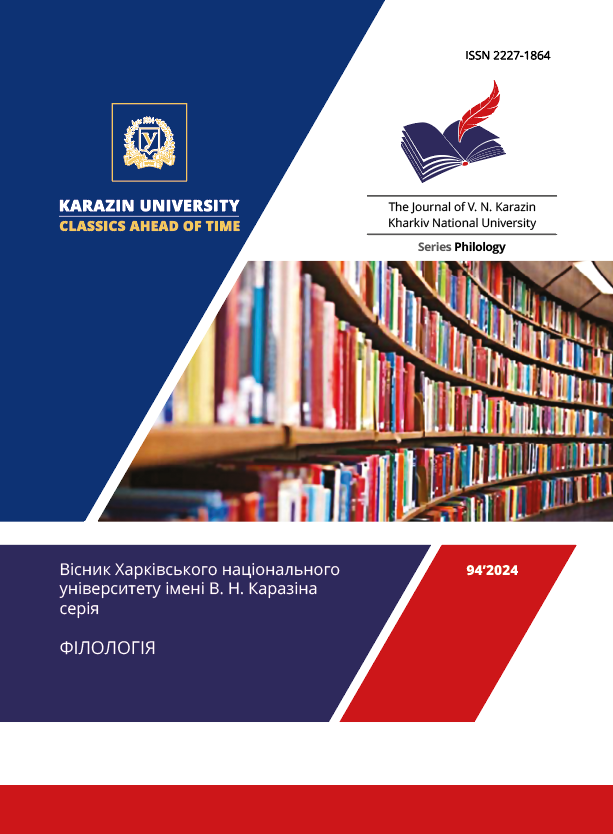From Bestial to Human: Neo-Mythological Reinterpretations of the Image of Delilah in Russian Literature at the Turn of the 20th-21st Centuries
Abstract
The article examines one of the eternal images of the world culture in a diachronic aspect, namely the interpretation and reinterpretation of the image of Delilah in Russian literature, primarily in poetry, from the 19th century to the present day. The novelty of the article involves the introduction into the scientific context of a number of neo-mythological texts and the provided scholarly commentary, as well as the study of the poetics of the myth and neo-myth with an emphasis on the ethical aspect in the context of ideas of Dmitry Ovsyaniko-Kulikovsky.
The relevance of the goal is connected with the opportunity to solve several interrelated scientific problems, since the functioning of mythological images and biblical stories, more precisely, the vector of conceptualization of their meanings, makes it possible not only to understand the specifics of the culture of perception, but also to evaluate the moral condition of society.
In the course of the study, the following trends in the reception of the plot were identified: a consistent shift in the interest of Russian authors from the character of Samson to Delilah, a change in the system of characters and methods of narration, a change in the modality of the image of Delilah, her transformation into a predominantly idyllic character. Particular attention in the article is paid to the political conceptualization of the image of Delilah, which is associated with the inclusion of the plot into the so-called barber text of Russian literature and culture.
The author of the article comes to the conclusion that the image of Delilah becomes conceptually dual in modern neo-mythological reinterpretations. The humanization of the image of Delilah, her evolution from bestial to human can be traced in love poetry. The refocusing of the authors’ attention from Samson to Delilah in social poetry leads to an increase in her role in the eternal plot, turning her into a politically ideological killer. The conducted research may also be interesting in the aspect of gender studies, since the analyzed material gives grounds to consider the image of Delilah in modern Russian literature as one of the representations of the femme fatale.
Downloads
References
Aleksandrov, A. (2014 May). “An era with a human face...” Volga. https://magazines.gorky.media/volga/2014/5/vesna-zanaveshena-tyulem-8230.html
Bobishev, D. (2005 April). “Episode”. Novij mir. https://imwerden.de/pdf/novy_mir_2005_04__ocr.pdf
Buhks, N. (2008). “Barber Code” in Russian Culture of the 20th Century”. Interpretation and Avant-garde: Collection of Scholarly Articles. Edited by Igor Loschilov. Novosibirsk: Printing House of Novosibirsk State Pedagogical University. https://raspopin.den-za-dnem.ru/pic-00004/2021-pdf/Inter-avangard.pdf
Cvetayeva, M. (1922). The Maiden Tsar. Moscow: State Printing House. P.64.
Elagina, E. (2009). Within Sight. Saint-Peterburg: Zvezda.
“Eternal” Plots and Images in Literature and Art of Russian Modernism, (2015). Edited by Andrey Toporkov. Moscow: Indrik.
Grigorjeva, L. (2007 September). “Samson and Dalilah”. Zvezda. P. 73.
Ilyushin, A. (2009 March). “Two Long Poems by Yu. F. Sidorin (“Michele Trivolis” and “The Good Vampire”)”. Humanities research in Eastern Siberia and the Far East. Pp. 74 – 85.
Kanevskij, G. (2014 Nr 43). “here come ivan and danila...” Novij bereg. https://magazines.gorky.media/bereg/2014/43/stihotvoreniya-186.html
Ken, L. (2008). “Samson in Chains” by Leonid Andreev: From Concept and Variants to Text”. Proceedings of the St. Petersburg State Institute of Culture. Pp. 29 – 43.
Kozanogin, S. (2011). “Interpretations of the Image of Samson from the “Book of Judges” in Russian Literature of the XIX - Beginning of the XX century”. Materials (Izvestiya) of the Volgograd State Pedagogical University. Pp. 105 108.
Kudimova, M. (2011). “The Echelon”. The Turn. Novosibirsk. Poetry library of the magazine “Siberian Lights”.
Leontjev, A. (2012 February). “Samson in Peterhof”. Novij mir. https://magazines.gorky.media/novyi_mi/2012/2/molochnyj-brat.html
Literature and Religion. A Collection of Scientific Papers, (2010). Edited by Ieva Kalniņa. Riga: Jauna Daugava.
Literature and Religion. A Collection of Scientific Papers. Saints and Sinners (2018). Edited by Ieva Kalniņa. Riga: Academic Press of the University of Latvia.
Ovsyaniko-Kulikovsky, Dm. (1989). Literary Critical Works. In 2 volumes. Vol. 2. From the “History of the Russian Intelligentsia”. Memories. Moscow: Khudozhestvennaya literatura.
Petrovykh, M. (1955). “The wind howls, the wind whistles...”. https://libverse.ru/petrovuh/veter-voyet-veter-svishchet.html
Sakson, L. (1999). Sakson and Dalilah. http://leonid-sakson.com/index.php/poeziya
Shiryayev, A. (2008 March). “At the Entrance of the Harbor”. Deti Ra. https://reading-hall.ru/publication.php?id=286
Stepanov, N. / Klementc, N. (1901). A Little Bit of Everything. Moskow: Printing House of G. Lissner & A. Geshelj. P. 32.
Vassilyeva, E. (2007). “The Body Language in “Samson Nazorei” by V. Zhabotinsky”. Proceedings of the Sefer Center. Scholarly Conferences in Jewish Studies. Part III. Pp. 248 – 258.
Voyvodich, Y. (2021). Neo-Mythologism in Contemporary Russian Prose. Moscow: Flinta.
Weisskopf, M. (2008). “Road to Gaza: Vladimir Zhabotinsky and the Search for Plot in the Theory and Practice of the Russian Avant-garde”. Interpretation and Avant-garde. Edited by Igor Loschilov. Novosibirsk: Printing House of Novosibirsk State Pedagogical University. https://raspopin.den-za-dnem.ru/pic-00004/2021-pdf/Inter-avangard.pdf
Zastyrets, A. (1999, 2003). “Didn’t you know, eh, Delilah?” Anthology of modern Ural poetry. Chelyabinsk: Printing House “Fond Galereya”. Vol. 2 (1997 – 2003).




